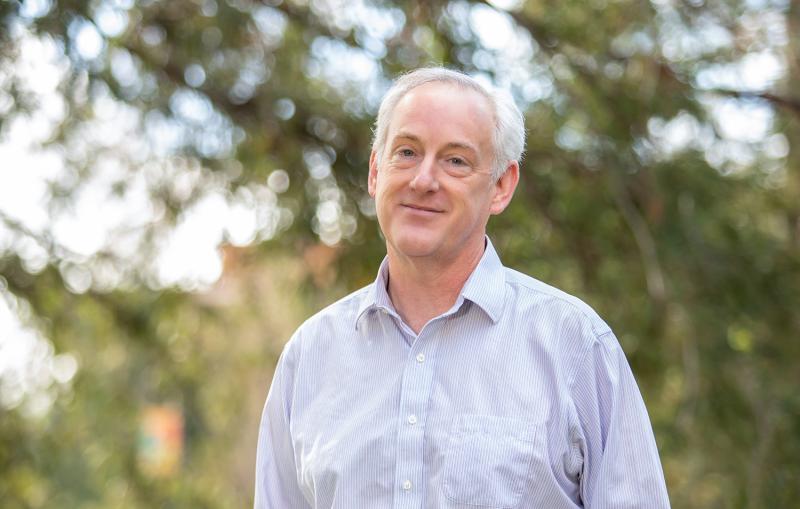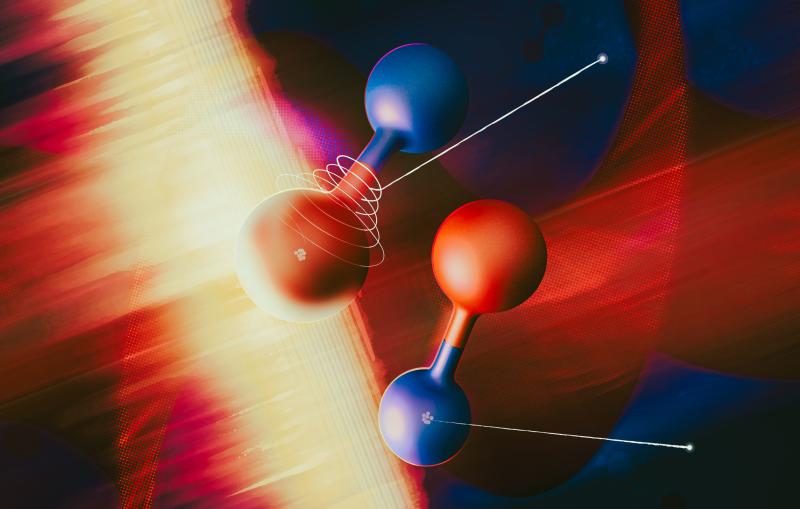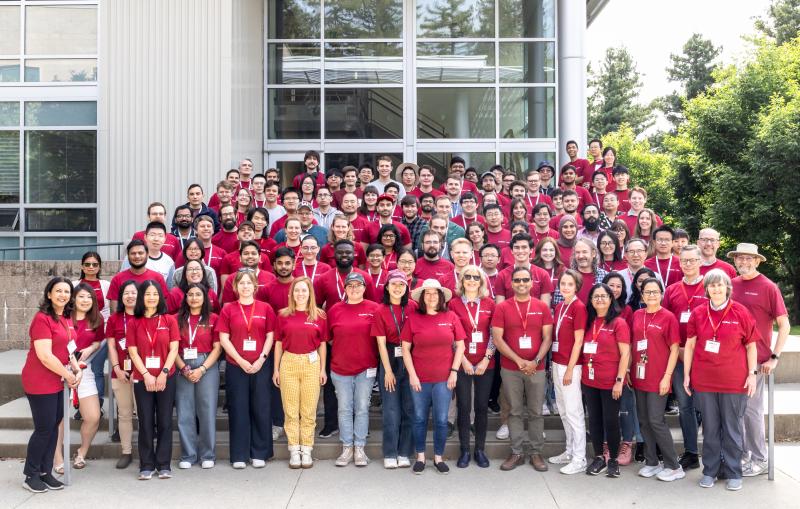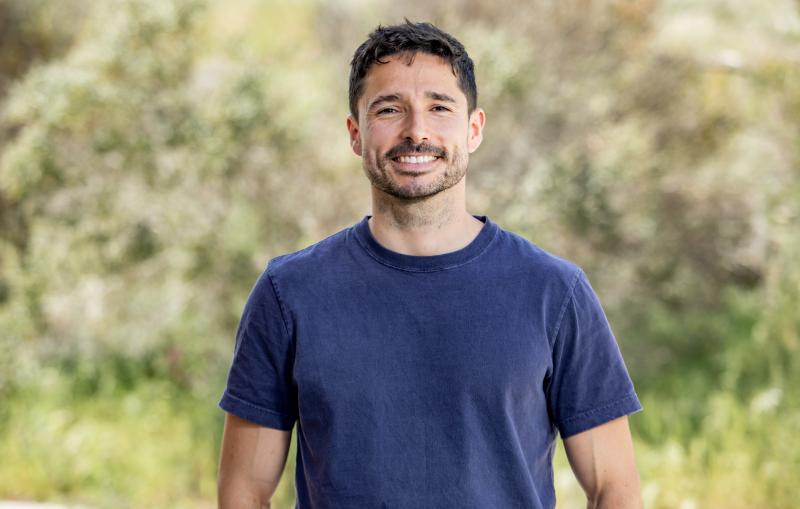Untangling a key step in photosynthetic oxygen production
Understanding nature’s process could inform the next generation of artificial photosynthetic systems that produce clean and renewable energy from sunlight and water.
By Ali Sundermier
Photosystem II is a protein complex in plants, algae and cyanobacteria that is responsible for splitting water and producing the oxygen we breathe. Over the past few years, an international collaboration between scientists at the Department of Energy’s Lawrence Berkeley National Laboratory, SLAC National Accelerator Laboratory and several other institutions have been able to observe various steps of this water-splitting cycle at the temperature at which it occurs in nature.
Now, the team has used the same method to zero in on a key step in which a water molecule moves in to bridge manganese and calcium atoms in the catalytic complex that splits water to produce breathable oxygen. What they learned brings them one step closer to obtaining a complete picture of this natural process, which could inform the next generation of artificial photosynthetic systems that produce clean and renewable energy from sunlight and water. Their results were published in the Proceedings of the National Academy of Sciences today.
“We demonstrated that it is possible to make these measurements in previous iterations of this work, but we never had the spatial resolution or enough time points to really drill down into these finer details,” says co-author Uwe Bergmann, a distinguished staff scientist at SLAC. “After carefully optimizing this experiment over many years, we honed our ability to make measurements at high enough quality to see these tiny changes for the first time.”
The bucket brigade
During photosynthesis, the oxygen-evolving complex, a cluster of four manganese atoms and one calcium atom connected by oxygen atoms, cycles through four stable oxidation states, known as S0 through S3, when exposed to sunlight.
On a baseball field, S0 would be the start of the game when a player on home base is ready to go to bat. S1-S3 would be players on first, second, and third. Every time a batter connects with a ball, or the complex absorbs a photon of sunlight, the player on the field advances one base. When the fourth ball is hit, the player slides into home, scoring a run or, in the case of Photosystem II, releasing breathable oxygen. This research focused on the transition from S2 to S3, the last stable intermediate state before an oxygen molecule is produced.
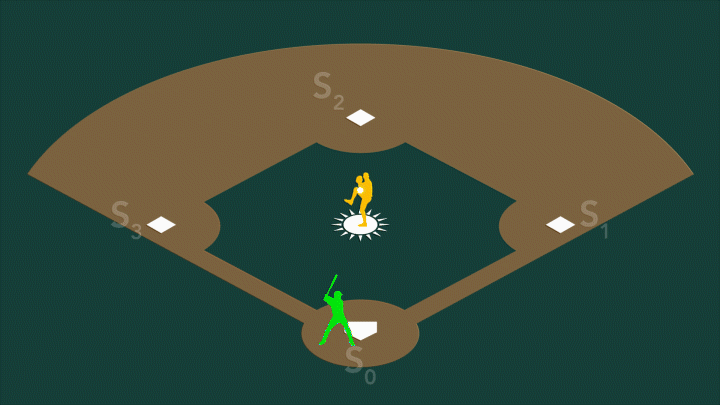
The oxygen-evolving complex is surrounded by water and protein. In the step the scientists looked at, water flows through a pathway into the complex, where one water molecule ultimately forms a bridge between a manganese atom and a calcium atom. This water molecule likely provides one of the oxygen atoms in the oxygen molecule produced at the end of the cycle.
Using SLAC’s Linac Coherent Light Source (LCLS) X-ray laser, the researchers found that water molecules are ferried into the complex as if through a bucket brigade: They move in many small steps from one end of the pathway to the other. They also showed that the calcium atom within the complex could be involved in shuttling the water in.
“It’s like a Newton’s Cradle,” says Vittal Yachandra, one of the authors of the study and a senior scientist at Berkeley Lab who has been working on Photosystem II for more than 35 years. “Usually in liquid water things are constantly moving around, but now we are in this fascinating situation where some of the water molecules around the manganese cluster change their position, while others are actually always in the same place. You can repeat the experiment 10,000 times and they will still be sitting in that same spot.”
Working in tandem
At LCLS, the team zapped samples from cyanobacteria with ultrafast pulses of X-rays to collect both X-ray crystallography and spectroscopy data to map how electrons flow in the oxygen-evolving complex of Photosystem II. Through this technique, they are able to simultaneously map its structure and uncover information about the chemical process at the manganese cluster.
Previously, the researchers had used this technique to make sure the sample was intact and importantly, also in the right intermediate chemical state. This paper marks the first time the researchers were able to merge the two sets of information to see connections between the structural and the chemical changes. This allowed the researchers to watch how the steps unfold in real time, and learn new things about the reaction.
“It is exciting to see the ‘cause and effect’ of changes induced by light absorption as they happen,” Yachandra says.
“It is easy to forget how critical the environment is and how it enables these really complicated processes,” says Junko Yano, one of the authors of the study and a senior scientist at Berkeley Lab. “Life does not happen in a vacuum; all components have to work together to make the reaction possible. These results show us how the protein and water molecules around the catalytic cluster work in tandem for making oxygen. Our results will start a new way of thinking and inspire new kinds of questions.”
Ready, set, action!
Beyond photosynthesis, Yano says, this technique can be applied to other enzymatic systems to make more detailed snapshots of catalytic reactions.
“It allows us to connect the structural biology and chemistry of systems to understand and control complicated chemical reactions,” she says.
The ultimate goal of the project is to piece together an atomic movie using many snapshots made throughout the process, including the elusive transient state at the end that bonds two oxygen atoms from two water molecules to form the oxygen molecule.
“Our dream is to go around the whole reaction cycle and get enough time points and details that you can see the entire process unfold, from the first photon of light coming in to the first molecule of breathable oxygen coming out,” says co-author Jan Kern, a staff scientist at Berkeley Lab. “We’ve been building the set for this movie, establishing our technique and showing what’s possible. Now the cameras are finally rolling and we can start working on the feature film.”
In addition to SLAC and Berkeley Lab, the collaboration includes researchers from Uppsala University and Umeå University in Sweden; Humboldt University of Berlin and the University of Heidelberg in Germany; the University of California, Berkeley and the University of California, San Francisco; the Diamond Light Source and the Rutherford Appleton Laboratory in the UK; and the Japan Synchrotron Radiation Research Institute and RIKEN SPring-8 Center in Japan.
Key components of this work were carried out at SLAC’s Stanford Synchrotron Radiation Lightsource (SSRL); Berkeley Lab’s Advanced Light Source (ALS) and National Energy Research Scientific Computing Center (NERSC); and the SPring-8 Angstrom Compact Free Electron Laser (SACLA) in Japan. LCLS, SSRL, ALS and NERSC are DOE Office of Science user facilities. This work was supported by the DOE Office of Science and the National Institutes of Health, among other funding agencies.
Citation: M. Ibrahim et al., Proceedings of the National Academy of Sciences, 20 May 2020 ( https://doi.org/10.1073/pnas.2000529117)
For questions or comments, contact the SLAC Office of Communications at communications@slac.stanford.edu.
SLAC is a vibrant multiprogram laboratory that explores how the universe works at the biggest, smallest and fastest scales and invents powerful tools used by scientists around the globe. With research spanning particle physics, astrophysics and cosmology, materials, chemistry, bio- and energy sciences and scientific computing, we help solve real-world problems and advance the interests of the nation.
SLAC is operated by Stanford University for the U.S. Department of Energy’s Office of Science. The Office of Science is the single largest supporter of basic research in the physical sciences in the United States and is working to address some of the most pressing challenges of our time.


